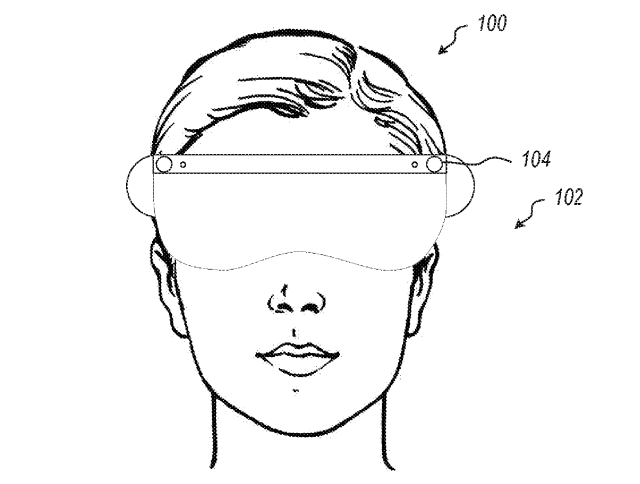Microsoft Patent | Systems and Methods of Increasing Light Detection in Color Imaging Sensors
Patent: Systems and Methods of Increasing Light Detection in Color Imaging Sensors
Publication Number: 20190027183
Publication Date: 2019-01-24
Applicants: Microsoft

Abstract
A device for detecting light includes a photoreceptor array that is sensitive to the visible light spectrum and has a first wavelength sensor, a second wavelength sensor, and a third wavelength sensor. The first wavelength sensor has a first peak sensitivity at a first wavelength. The second wavelength sensor has a second peak sensitivity at a second wavelength. The third wavelength sensor has a third peak sensitivity at a third wavelength. The first wavelength sensor has a first base sensitivity at least 30% of the first peak sensitivity at the second wavelength and third wavelength. The second wavelength sensor has a second base sensitivity at least 30% of the second peak sensitivity at the first wavelength and third wavelength. The third wavelength sensor has a third base sensitivity at least 30% of the third peak sensitivity at the first wavelength and second wavelength.
Background
Use of computing devices is becoming more ubiquitous by the day. Computing devices range from standard desktop computers to wearable computing technology and computers integrated into many commonplace devices. Due to the variety of device and applications, computing devices are being used in an ever-increasing variety of environments and conditions.
Some computing devices including imaging sensors to image the surrounding environment or aspects of the environment near the computer. For example, some wearable devices, such as head-mounted displays, image the environment to replicate the field of view of the user. Other computing devices are integrated into devices, such as automobiles or factory machinery to assist a human operator in operating the device in a safe manner. Other computing devices are incorporated into devices to allow partially or fully autonomous operation of the device.
The environments in which the computing devices are used vary from bright sunlight, for example, in an automobile on a road surface in the middle of the day, to poorly illuminated–or unilluminated–indoor or sheltered environments, such as a user’s basement, a warehouse, nighttime applications, or underwater applications. Conventional imaging sensors compromise light detection for color image reconstruction. This compromise can limit the application of color imaging sensors in low-light applications.
Summary
In some embodiments, a device for detecting light includes a photoreceptor array that is sensitive to the visible light spectrum and has a first wavelength sensor, a second wavelength sensor, and a third wavelength sensor. The first wavelength sensor has a first peak sensitivity at a first wavelength. The second wavelength sensor has a second peak sensitivity at a second wavelength. The third wavelength sensor has a third peak sensitivity at a third wavelength. The first wavelength sensor has a first base sensitivity at least 30% of the first peak sensitivity at the second wavelength and third wavelength. The second wavelength sensor has a second base sensitivity at least 30% of the second peak sensitivity at the first wavelength and third wavelength. The third wavelength sensor has a third base sensitivity at least 30% of the third peak sensitivity at the first wavelength and second wavelength.
In other embodiments, a device for detecting light includes a photoreceptor array that is sensitive to the visible light spectrum and has a Bayer pattern including a first wavelength sensor, a second wavelength sensor, a third wavelength sensor, and a fourth wavelength sensor. The first wavelength sensor has a first peak sensitivity at a first wavelength. The second wavelength sensor has a second peak sensitivity at a second wavelength. The third wavelength sensor has a third peak sensitivity at a third wavelength. The fourth wavelength sensor has a fourth peak sensitivity in the infrared spectrum. The first wavelength sensor has a first base sensitivity at least 30% of the first peak sensitivity at the second wavelength and third wavelength. The second wavelength sensor has a second base sensitivity at least 30% of the second peak sensitivity at the first wavelength and third wavelength. The third wavelength sensor has a third base sensitivity at least 30% of the third peak sensitivity at the first wavelength and second wavelength.
In yet other embodiments, a method of manufacturing an imaging sensor includes providing a photoreceptor array having at least one domain. The method further includes positioning a first partial filter over a first pixel of a domain of the photoreceptor array, positioning a second partial filter over a second pixel of the domain of the photoreceptor array, and positioning a third partial filter over a third pixel of the domain of the photoreceptor array.
This summary is provided to introduce a selection of concepts that are further described below in the detailed description. This summary is not intended to identify key or essential features of the claimed subject matter, nor is it intended to be used as an aid in limiting the scope of the claimed subject matter.
Additional features and advantages of embodiments of the disclosure will be set forth in the description which follows, and in part will be obvious from the description, or may be learned by the practice of such embodiments. The features and advantages of such embodiments may be realized and obtained by means of the instruments and combinations particularly pointed out in the appended claims. These and other features will become more fully apparent from the following description and appended claims, or may be learned by the practice of such embodiments as set forth hereinafter.




